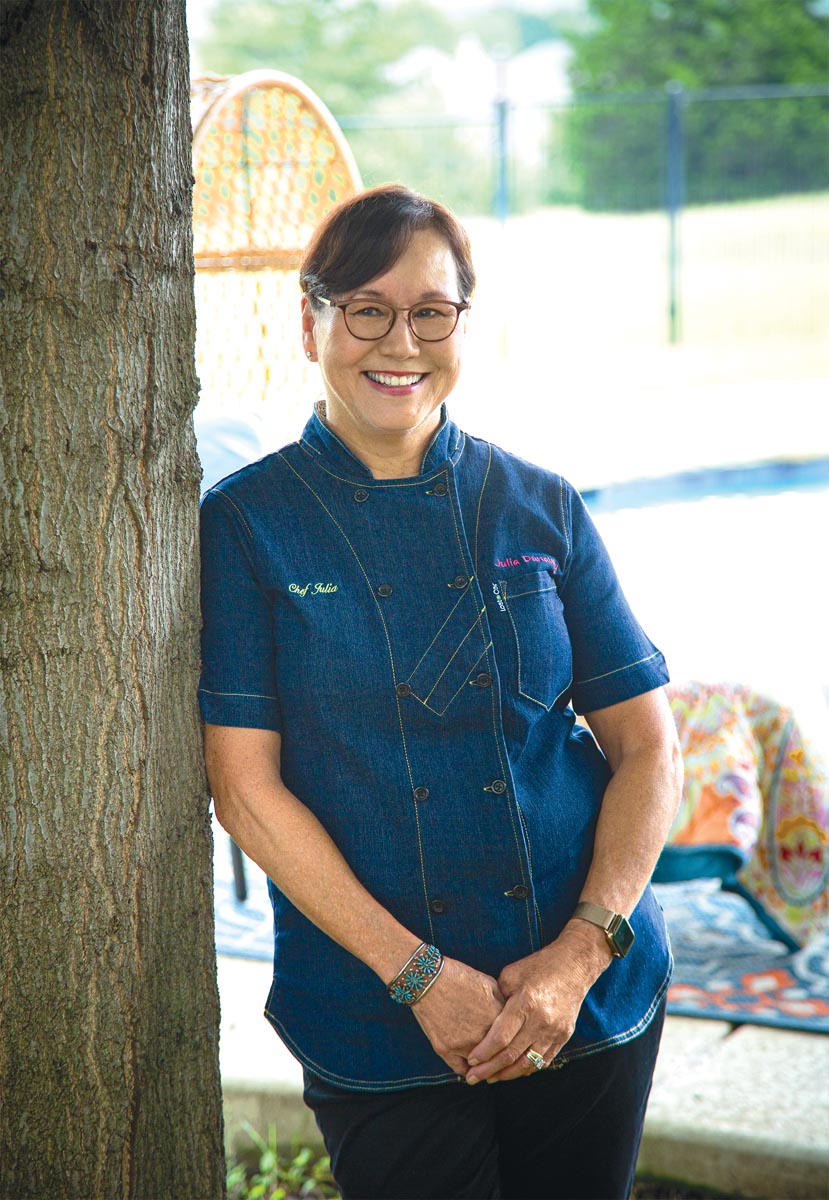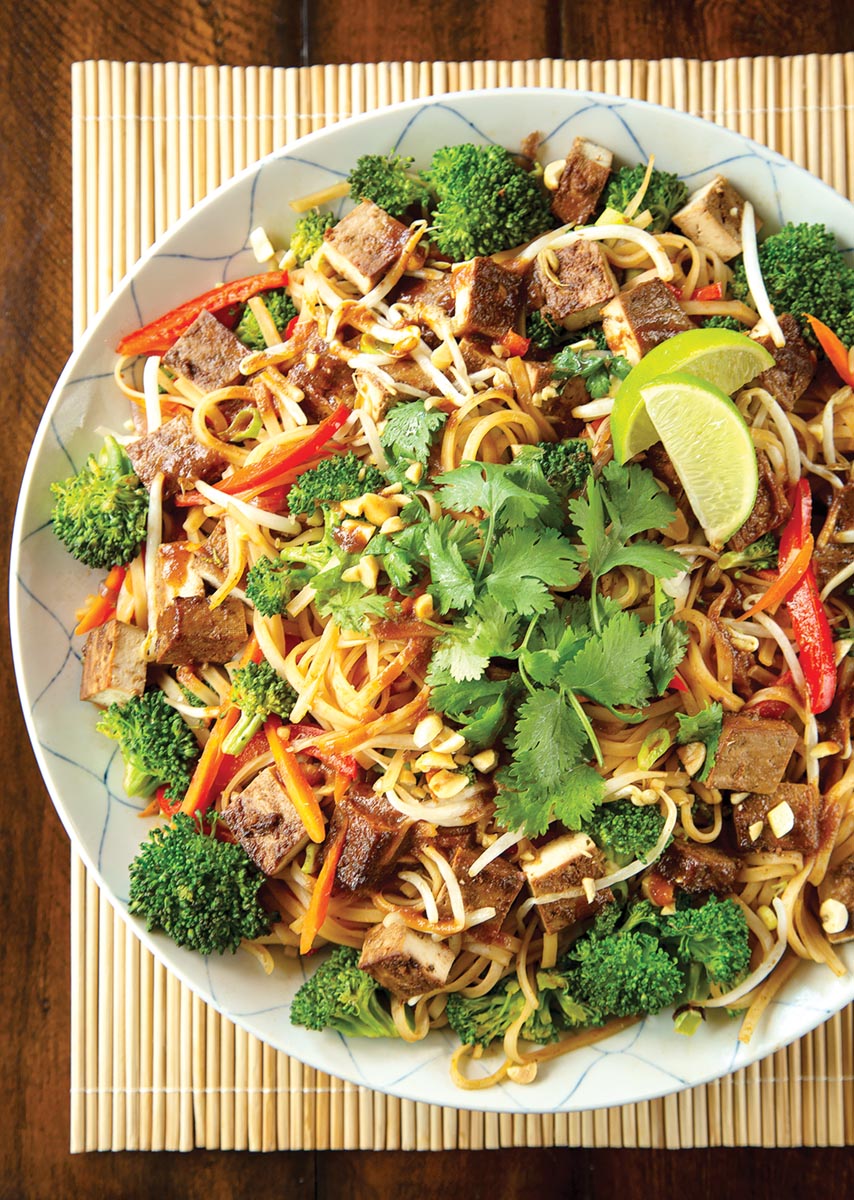
No Meat. No Problem.
By June Naylor
Photos by Ralph Lauer
Chef Julia Dunaway’s switch to plant-based cooking has paid off personally and professionally.
While many of us have been digging into comfort food and meaty casseroles as we shelter at home, chef Julia Dunaway has stayed the course with online classes featuring her plant-based dishes, such as roasted vegetable tacos and crispy taquitos, Japanese curry, and coconut oatmeal cookies with dark chocolate. (Plant-based meals contain no meat, dairy, sugar, processed food or oils, including what we typically consider the healthy ones from olives or avocados.)
Having already built an impressive online following, Dunaway happened to be kicking off a program of 50 free cooking videos in 50 days as the pandemic struck. Viewers from around the country tuned in. But even before the arrival of COVID-19, the hands-on lessons in healthy food preparations at her Azle residence routinely sold out.
Things were much different two years ago, when the chef changed her way of eating due to heart and health reasons. Adhering mostly to a plant-based diet allowed her to switch to a minimal dosage of blood pressure medicine, quit taking her cholesterol-lowering meds and lose weight. Feeling good was a huge reward. “Now my energy level is high, my mind is clear, and I have no chronic health concerns.”
But her culinary classes suffered. Lack of interest forced her to cancel half of her lessons based on a strict plant-based culinary program. “I was really getting discouraged, but everything turned around in 2019.” Just as her own story changed, so did the public mindset. “People are so happy to find out how to eat vegetables, because their experiences were so bland before. With all the herbs, seasonings and spices, the foods just wake up,” says Dunaway. “And students tell me they can’t find these classes anywhere else.” When a client flew in from Maryland, the chef knew her business had turned an important corner.
After wrapping up her 50-days project in May (all lessons are still available online), she continues to offer new free videos while also hosting weekly paid Zoom classes. And this month, she resumes classes in her spacious light-filled kitchen at home, where her gardens are full of the fresh herbs and vegetables incorporated in many of her dishes.
Always experimenting, she shares her creations with her carnivorous husband, who, for the most part, is a willing taste tester. Dunaway says she doesn’t miss meat or anything from the omnivore diet she once loved. “When you eat the way I do, you stop wanting salty and sweet things, or anything cooked in oils. And now, everything tastes so much better.”
THE DETAILS
Chef Julia Weekly virtual classes on Zoom cost $20; you receive a detailed recipe packet at registration so you can cook along with the class as it streams online. Find details and buy her newly released e-book, 50 Recipes in 50 Days of Daily Facebook Live Videos, at chef-julia.com, $20. Follow her Facebook page @ChefJuliaDunaway for updated information on when her in-home cooking classes will resume.
Dunaway suggests doubling the tofu recipe. It freezes well and also is good in stir-fry dishes, fried rice and red or green curry. To watch her tutorials on Facebook, visit the Chef Julia page and click on “Videos.”
Sesame Ginger Tofu Pad Thai
Serves 3 to 4
Sesame Ginger Tofu
- (14 ounce) block extra-firm tofu
- 4 tablespoons low-sodium soy sauce (or tamari, regular soy sauce or coconut aminos)
- 1 tablespoon tahini
- 1 teaspoon grated ginger
- 1 teaspoon minced garlic
Heat oven to 400 degrees (375 if using a convection oven). Drain liquid from tofu and wrap it in paper or cloth towels. Press between two cutting boards weighted with a heavy book (or use tofu press) for 15 to 20 minutes. Slice into slabs by cutting block in half, then repeating until you have 8 equal pieces. (For this recipe, use about 5 slabs of the prepared tofu. Freeze extra.)
Combine soy sauce, tahini, ginger and garlic in large plastic self-closing bag or shallow glass container. Add tofu slabs in single layer and cover with marinade, coating all sides well. Marinate for at least 30 minutes.
Place tofu in single layer on baking sheet lined with parchment and bake for 20 minutes; flip slices and bake 5 minutes more. (Cut into smaller pieces for this recipe.)
Pad Thai
- Pad Thai sauce (see Note)
- ½ cup sliced red onion
- Water or vegetable stock, as necessary
- 1 broccoli crown, cut into florets
- 3 small carrots, cut into matchsticks
- ½ yellow or red bell pepper, cut into matchsticks
- 7 ounces rice noodles, prepared per package directions
- Soy sauce, to taste
- 1 cup fresh bean sprouts
- 2 scallions, thinly sliced
- ½ cup chopped roasted peanuts
- ½ cup fresh cilantro leaves
- Lime wedges
Note To make Pad Thai sauce, combine in jar with tight-fitting lid: 4 tablespoons low-sodium soy sauce (or tamari or coconut aminos) with 2 tablespoons each lime juice, brown (or regular) rice vinegar and coconut (or date or cane) sugar. Add 1 tablespoon vegan fish sauce (VFish is a popular brand), 1 grated garlic clove, 2 teaspoons Sriracha sauce and 3 to 4 tablespoons vegetable stock or water. Close, shake well and set aside.
In a large skillet over medium-high heat, add onion and cook 2 to 3 minutes until it starts to caramelize. Add small amount of stock or water if necessary. Add remaining vegetables, 2 to 3 tablespoons of stock and cover pan, cooking for 3 minutes. Remove vegetables and set aside in bowl. Place Pad Thai sauce in skillet and bring to simmer. Add cooked noodles and stir well. Add prepared sesame-ginger tofu and stir. Return vegetables to skillet, mixing well. If Pad Thai seems too dry, add more water or stock to make more sauce.
Transfer Pad Thai to large serving dish or individual plates, sprinkling with soy sauce and garnishing with bean sprouts, scallions, peanuts, cilantro and lime wedges.


